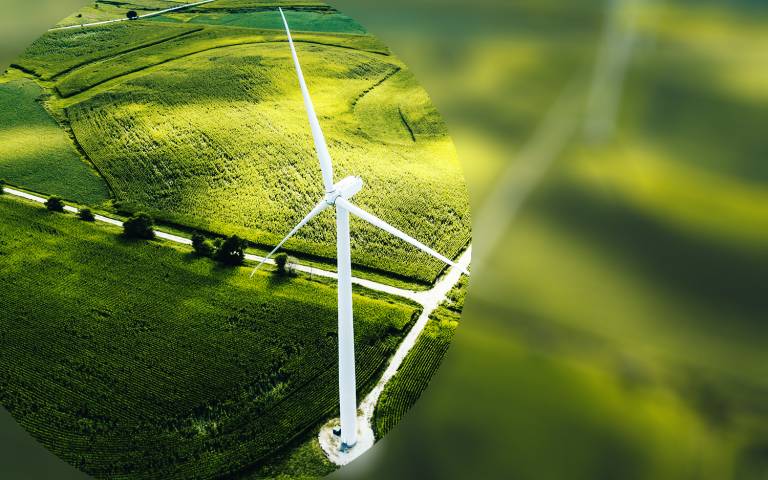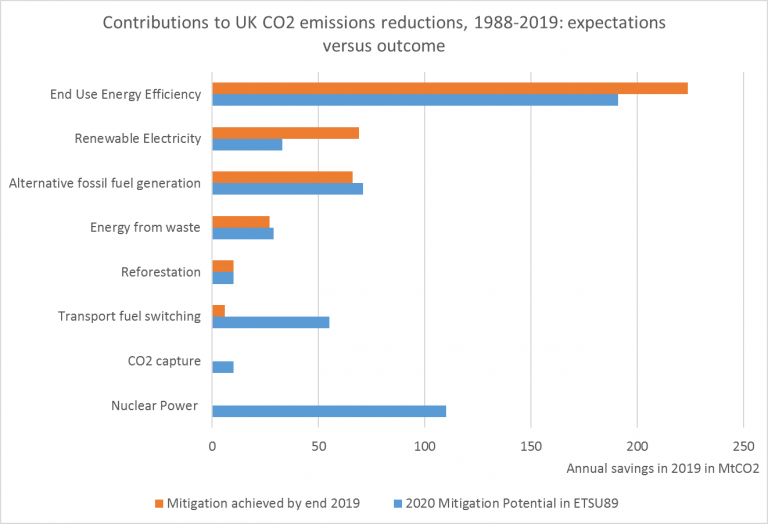Thirty years of UK CO2 reduction: what have we learned?
6 August 2021

Note: In April 1989, the UK Prime Minister, Margaret Thatcher, convened a full cabinet meeting on climate change addressed by leading scientists. The presentation on mitigation of carbon dioxide emissions was made by the Head of the Energy Technology Support Unit (ETSU), Ken Currie. It identified 8 potential options for mitigation by 2020.
Thirty years later, Eoin Lees and Nick Eyre, two of the team that prepared the presentation, have revisited the original assessment. They compare the mitigation potential identified then with what we actually achieved by 2019.
In the 1989 paper, emissions reductions totalling 477 Mt CO2 were identified, which, if implemented, would reduce emissions from a ‘business as usual’ 2020 projection of 770 Mt CO2 to 293 Mt CO2, 50% below the actual 1988 level. In practice, the actual emissions in 2019 (last pre-Covid year) were 352 Mt CO2. The comparison between project potential and outcome achieved is shown below.

The largest mitigation options identified were better energy efficiency and the generation of low carbon electricity. The re-analysis finds these have been the key options adopted.
The projected improvements in energy efficiency were widely considered to be ambitious in 1989, but have been achieved. They have been spread across the three major categories of energy use: electricity (32%, 123 Mt CO2) heating (34%, 68 Mt CO2) and transport (32%, 33 Mt CO2). The emissions reductions from saving electricity are particularly large, as the baseline projection in line with Government policy, assumed electricity would be largely coal-fired.
Decarbonisation of electricity has also been achieved by the displacement of coal, initially by the ‘dash for gas’ in the 1990s, and more recently by the rapid rise in renewable electricity generation, particularly wind power. Neither was projected very well in the 1989 report. In the case of gas, this was because it was not allowed for use in power generation at the time and a change in that regulation was not foreseen. Renewable electricity generation has exceeded 1989 expectations, although only in the last few years, due to a combination of global cost reductions and effective policy support.
In contrast, the 1989 report envisaged a very large additional contribution by nuclear electricity, which has not been realised. While nuclear energy was already controversial, it was strongly supported at the time of the Sizewell B enquiry by the Government. In practice, that support faded as the realities dawned of nuclear power’s inability to compete in liberalised electricity markets. Nuclear generation is now actually less than in 1988.
Interestingly for a modern audience, carbon capture and storage (CCS) had already been identified as an option 30 years ago. It was projected that one large UK demonstration project might be built by 2020. Of course that has not happened. However, it really would have been difficult in 1989 to foresee the twists and turns in CCS policy over 30 years and not altogether surprising that the fossil fuel industry hasn’t demonstrated the technique.
As well as measuring what actually happened in the last 30 years, it is important to explore what we might learn for the 30 years to 2050, in which more radical change is needed if we are to get anywhere near net zero by 2050. The most obvious lesson is that a broad statement of policy intention alone counts for nothing, as the last 30 years of nuclear stagnation shows. Even a legal commitment should be treated with caution: as the rapid expansion of gas-fired generation in the 1990s shows, laws can be changed.
So the UK Climate Change Act alone does not make net zero by 2050 inevitable. Achieving it will require a formidable energy transition. There will be opposition. And some hard-headed analysis is needed, as we do not have time to go on ‘picking losers’. The last 30 years shows that a favourable policy environment is critical. Energy efficiency and renewable energy have been the success stories of that period, but it has not been a consistent story. They have only progressed fast in periods when, unlike today, there has been policy support. Another finding is that with favourable conditions, modular mass-produced energy efficiency products and renewable energy technologies can be deployed and improved quickly, outstripping their more lumbering energy sector competitors.
A second lesson is that, although public and media debate tends to focus on debates about energy supply, energy demand matters at least as much. Finally, following Brexit it is clear that sustainable energy policies should continue to benefit from close alliance with EU initiatives.
Halving energy use by 2050 and converting the rest to renewables is perfectly possible. Today’s researchers have an opportunity to contribute to that process. And hopefully younger colleagues will stick around for 30 years’ time to evaluate how we get on!
 Close
Close


